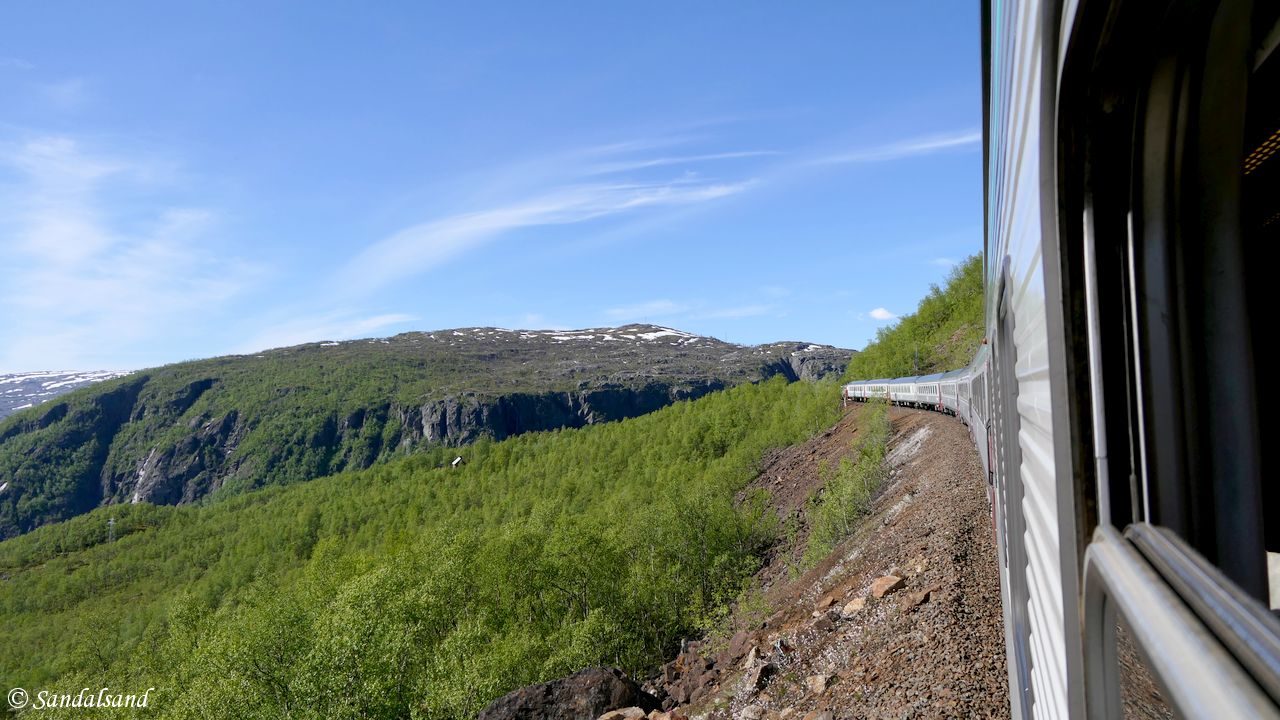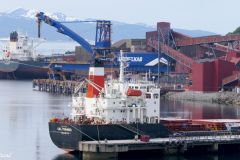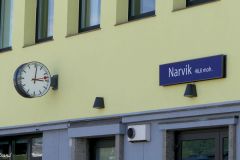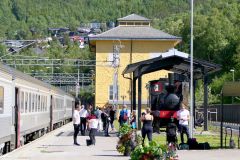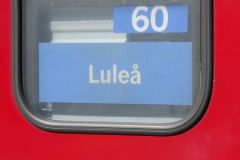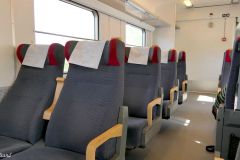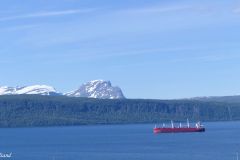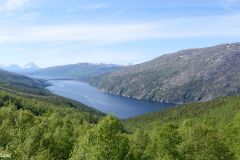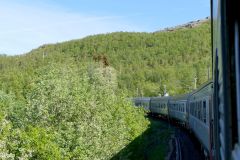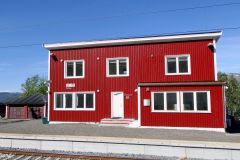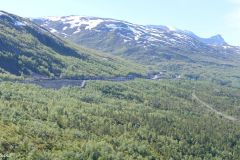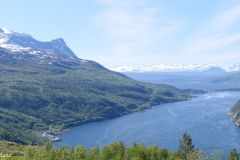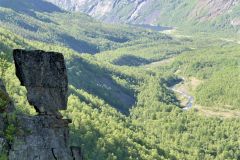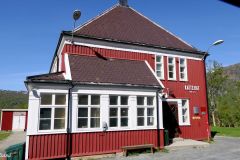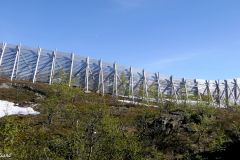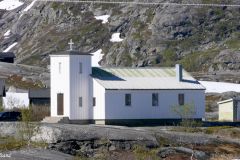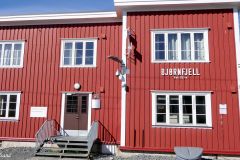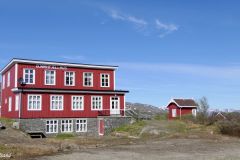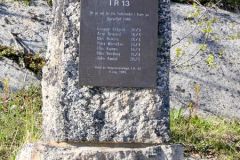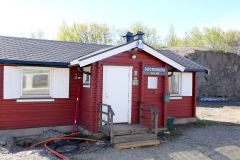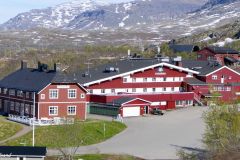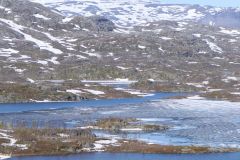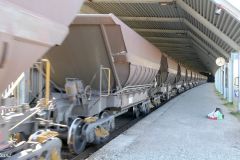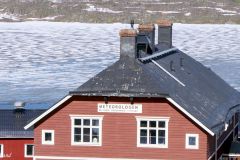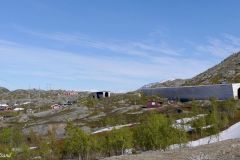The Ofoten line is one of Europe’s most awesome railway lines. It crosses Norway in less than 43 km, going from the fjord up into the mountains. The landscape is as wild and dramatic as the story behind its construction, and the WWII story about the importance of it. The Ofoten line is unique for a number of reasons.
In this article you will first get some background information about the line itself, then a report from my own trip with the passenger train from Narvik to the Riksgränsen station on the Swedish side, and finally some practical information. (THIS ARTICLE IS ALSO AVAILABLE IN NORWEGIAN.)
Background
Where does it go?
The Ofotbanen (Norwegian name) crosses Norway over a distance of approximately 43 kilometres from the harbour in Narvik to the border with Sweden. It rises from something close to zero metres above sea level to 523 metres at Riksgränsen station. On the Swedish side, the Malmbanan as it is called, continues an additional 500 km to Luleå in the Bay of Bothnia with further divisions to the Swedish domestic network. There are some passenger trains on the same stretch, but the iron ore trains from the big mines at Kiruna and Malmberget are the reason why the track was built, and the most important reason why it is still in use. The line is not connected directly with the the rest of the Norwegian rail network.
Why was it built?
The iron ore fields in northern Sweden are among the world’s richest, and were already known in the 17th century. At that time and until the Ofotbanen was opened in 1902, it was not easy to get the ore out on the world market. In the beginning there was nothing besides an endless wilderness, native Sami people and their reindeer. It was also the Sami who were employed to transport the ore, in combination with shipping over water and down the rivers. Of course, this did not provide a basis for any major production. A railway was therefore proposed as a solution in 1869. The coastal town of Luleå in Sweden is located just as far from the ore deposits as Narvik, but the problem was then and now that the Bay of Bothnia freezes during winter. That meant that the season was very short.
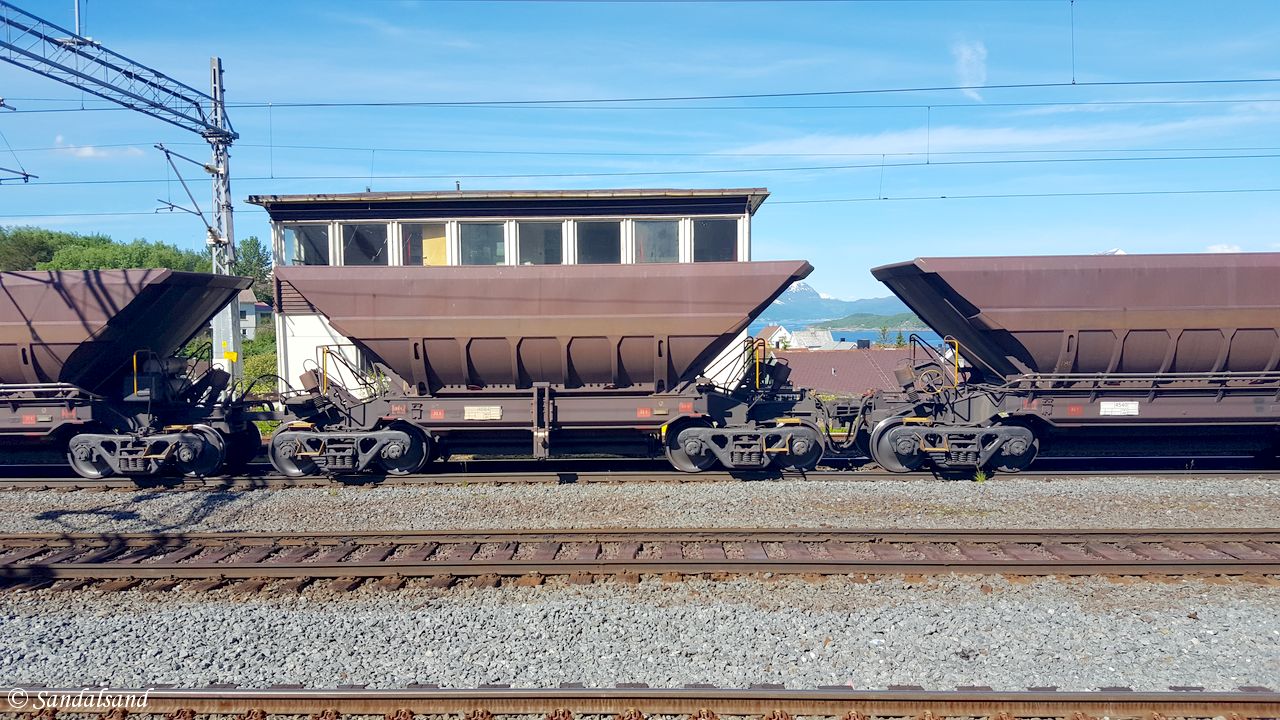
A passing iron ore train at the Narvik station. 750 metres long, 68 carriages each with 100 tonnes of iron ore inside.
Therefore, in the Union between Sweden and Norway, it was politically opportune, as well as commercially interesting, to look into the possibility of shipping the ore from the ice-free Norwegian coast. The Gulf Stream provides natural ice-free ports in Norway. On the Swedish side, they managed to finish a railway line down to Luleå in 1888. However, the Norwegian government hesitated until 1898 before making the final decision to develop the railway. Various companies, including British, had been working on solutions to the task of building the line, but when the decision was finally taken, things went about very quickly.
The construction period
In a short period of time, there was a fairly massive immigration of workers from near and far. The Rallare as they were called in Sweden (navvy in English) arrived in large numbers. The largest place during this ‘Klondyke period’ was in Rombaksbotn, at the end of the deepest fjord in the region and only 8 km as the crow flies from Sweden. Here a community of 700 people boomed. Here were shops, bakery, cafes and hotels, here were liquor stores and a brothel. As probably the only place in Norway of this size, there was no church. From here legends grew of the rallar cook “Svarta Bjørn” (Black Bear). She is honoured annually today, through an annual march from Bjørnfjell to Rombaksbotn during the Narvik Winter Festival. There is little left of this boom-town settlement today.
Fights during WWII
The heaviest fights in Norway during World War II took place in and around Narvik in April, May and June 1940. The city and harbour were bombed and burned, two large naval battles were fought with heavy casualties and on land the battle between Norwegian, French, British and Polish forces, and the Germans waved back and forth for 62 days. At Bjørnfjell on the Ofotbanen we find a memorial near the track – the fights were hard up there on the mountain.
The Norddal Bridge, which we can see today at a distance, was designed to be blasted in case of war. Indeed, it was a concession claim from the Norwegian government in 1898. At that time there was a great fear of a Russian invasion of the entire Cap of the North, i.e. the northern parts of Norway, Sweden and Finland. The Norwegian forces failed in 1940 to blow the bridge. We know the end result: The Ofotbanen continued to function throughout the war. As a result of the battle, Narvik has been very prominent in the collective memory of the French especially.
One might put it this way: Narvik and the role of the Ofotbanen was the main reason why the great powers had an interest in Norway at all prior to the war. Norway’s preferred neutrality was deliberately set aside by the Germans and the British. The country was pulled into the war as a result of fear that the other party would gain control of a Norwegian railway line and a Norwegian harbour. Obviously, this provides the basis for further reflection when you take the train across the valley and into the mountains.
The line today
One will find that the railway tracks of today follows exactly the same route as in 1902. The only exception is that the Norddal Bridge was retired in 1988 and new tracks were laid deeper in the valley. This does not mean that the railway has been untouched for over a hundred years. For one, it was electrified in 1923, as the second in Norway, and automated in the sixties as the first in Norway. Furthermore, traffic is so demanding on the track and everything that maintenance costs and needs are constantly high.
Natural conditions in a rough climate obviously contribute to the same. Over the years, there have been made more and longer crossing tracks, tunnels and snow sheds, all to ensure efficiency and operational stability. The track is now able to withstand 30 tonnes axle loads compared to the normal 22.5 in Norway. The world’s strongest locomotives are being used.
Traffic on the Ofoten line
Every day 10-11 trains run from Kiruna to Narvik. A train consists of 68 cars each loaded with 100 tonnes of ore and pellets. They run straight down to the port where automated solutions allow each car to be emptied in five seconds and all the carriages in six minutes. The silos in the harbour have large storage capacity. 750 meter long trains are both heard and seen almost everywhere in the city.
The mining company LKAB is the best known and most people would associate the ore trains with them. Since 2013, Canadian Northland Resources has also established itself with mining in northern Sweden and contributes to this amount of iron ore trains. In addition, a cooperation between Norway and Sweden has been established for several years, where freight trains (Arctic Rail Express) commute between Alnabru in Oslo and Narvik, via Sweden. 90% of the food supply to Northern Norway is transported in this way. DB Schenker also has freight trains on the route.
Importance
In fact, Ofotbanen accounts for more than half of all freight transport on track in Norway, measured in tonnes. It is estimated that the need for double tracks will arise in a few years time.
Given all this, it is clear that Narvik is an important city in northern Norway, and that freight transport is important to Narvik. Surely, the Ofotbanen was also the very reason Narvik was founded. Initially the place was called Victoriahamn, named after the British Queen. However, an unofficial referendum in 1900 changed its name to Narvik.
The first train could roll down the tracks on November 15, 1902. Due to the lack of daylight at that time of year and the winter season, the official opening had to be postponed. King Oscar II was present at the official opening of the Ofotbanen on July 14, 1903.
Experiences
Our start in Narvik
It was a brilliant and beautiful summer day when we took the train from Narvik station almost on the day 114 years after King Oscar II. The day could not have been better and the view up the mountain side was unforgettable. The only nuisance was that the windows could have been a bit cleaner, but when the temperature was on our side, we just pulled the windows down and enjoyed the scenery and photo opportunities along the way.
Of course we did not sit in an empty iron ore car on our way. Passenger trains run from Narvik station (46.6 m), a beautiful station building opened in 1902, about 3.7 km from the harbour. Our journey was therefore shorter (39 km) than the official length of the Ofotbanen, but who cares? This is a nice little train station, with not many changes made during the last hundred years and indeed there is also an old steam locomotive placed on the platform, as a museum object of course. It is Swedish company SJ which operates the passenger trains at Ofotbanen. The Swedish conductor was nice and helpful.
Stations on the line – Rombak
There have been more stations along the track, but there are some left with opportunities to get off and on. We noticed that both hikers and mountain cabin owners use this opportunity to get into the mountains.
The first station we stop at is Rombak Station (20.86 km from Narvik harbour, 264.7 metres above sea level). The station was opened in 1902 at the same time as the line and has a a red-painted station building. Several similar buildings are encountered at the next station, Katterat (29.73 km, 373.5 metres, also opened in 1902). Until 1951 it was called Hundalen. The station used to be manned and there was actually a small community here. Several buildings are left around, apparently well maintained.
Stations on the line – Søsterbekk
Next we arrive at Søsterbekk (1988, 36.05 km, 457 m). A station with the same name was previously located elsewhere, but as a result of relocation of the line it was moved here in 1988. Here we find more cabins, and the stop obviously being used by the cabin people. Our train did not stop here. There is a small service building at this train stop.
Stations on the line – Bjørnfjell
The next station is the last on the Norwegian side of the border. Bjørnfjell station (1902, 40.42 km, 513.9 m) (I love the precise use of decimals among the railway people). Here we are on top of the mountains, with several tunnels and snow sheds before and after, besides many cabins and even a chapel out on the flats. During our visit at the end of June there were still patches of snow around and some ice on the water. It was a pity that the stops on these stations were far too short to leave the train and have a look around.
Stations on the line – Riksgränsen (Sweden)
Then, through another tunnel or snow shed, we roll into Sweden. In the dark, we detect that a marker has been set exactly where the boundary is passed. Riksgränsen is 42.99 kilometres from Narvik harbour. Before 1925 the station was on the actual border line one kilometre back. There staff and locomotives were exchanged. Riksgränsen (meaning Country Border) is of course a strange name for a place, but it is meaningful. Here we find resorts, several hotels and cabins around. From Narvik, people come up to shop at the ICA store. Some come by train, but I guess most people choose the main car road (E10) which continues into Sweden.
Here we left the train. The journey between Narvik and Riksgränsen takes 45-50 minutes. Within the hour, we took another train back to Narvik, and were very pleased with the trip.
Practical stuff
Passenger train tickets are available for purchase at the Narvik station, online or by a vending machine. There are no vending machines on the other stations. Parking spaces are found on the back of the building.
As mentioned, a Swedish company is running the passenger trains in and out of Narvik. Our train had carriages going to Luleå. One sleeper car was destined for an overnight trip to Stockholm (1580 km). Find the timetables on this page. (The error message will appear due to the wrong date in the link, but please enter your own dates.) You will see that the timetables vary during the week, but you should be able to find two trains that provide a stay at Riksgränsen station that is not too long. Our stay was less than an hour but other combinations could take several hours.
It is also possible to take the train to Riksgränsen or Bjørnfjell on the Norwegian side, and then walk Rallarveien back / down to Rombaksbotn. A guided tour is offered, which ends with a RIB boat in the fjord.
Other links: Lexical information on Wikipedia, tourist information on Visit Narvik and NordNorge.
Finally: Check out my video from this trip.
